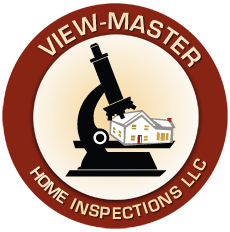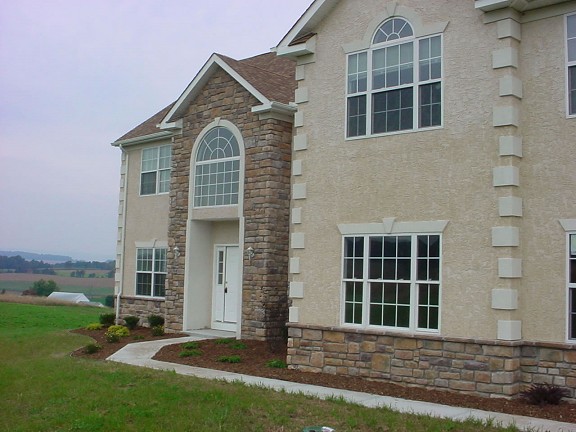EIFS
Exterior Insulation Finishing System
Very few home inspectors are able to tell the difference between EIFS and Stucco
Exterior Insulation Finish Systems (“EIFS”) are a type of building product that provides exterior walls with a finished surface, insulation and waterproofing in an integrated composite system. EIFS is also known as “synthetic stucco” and “Senergy”, “Finestone”, “Dryvit” or “Sto” – popular EIFS brands.
Typical EIFS Stucco Look
Terminology
EIFS is not ‘stucco’ in the sense of the word stucco. Traditional stucco is often called Portland Cement Plaster, and is a centuries-old non-insulating material. Stucco consists of sand, Portland Cement, and water, and is a hard, dense, thick, non-insulating material. EIFS is a modern, lightweight synthetic wall cladding that includes foam plastic insulation and thin synthetic coatings. There are also specialty stuccos that use synthetic materials but no insulation, and these are also not EIFS either. A common example is what is called one-coat stucco, which is a thick, synethic stucco applied in a single layer (traditional stucco is applied in 3 layers). There is also an EIFS-like product called a Direct-Applied Finish System (or DAFS), which is essentially an EIFS but without the insulation – this product is also not EIFS either, and has quite different characteristics.
EIFS are proprietary systems of a particular EIFS producer and consist of specific components. EIFS are not generic products made from common separate materials. To function properly, EIFS needs to be architecturally designed and installed as a system.
There are a number of versions of EIFS, as described below. The most basic and common EIFS is called a barrier EIFS (also known as a traditional or conventional EIFS). Another type is called an EIFS with Drainage, which is a barrier EIFS to which a water drainage capability has been added.
A basic EIFS includes only the insulation and EIFS materials (coatings, adhesives, etc.). Other types of EIFS may also include plastic or metal edge trim, water-resistive barriers, a drainage cavity, and other accessories. The technical definition of “an EIFS” does not include wall framing, sheathing, flashings, caulking, water barriers, windows, doors, and other wall components. However, as of recently, architects have begin specifying flashings and sealants as being a part of the EIFS scope of work, essentially requiring EIFS contractors to carry out that work as well. The technical national consensus standard for the definition of an EIFS, as published by ASTM International organization, does not include flashing or sealants as part of the EIFS.
How EIFS is Used
EIFS can be used on a wide range of buildings, including homes, apartments, condo’s, high-rise buildings, offices, malls, shopping centers, hotels, motels, clinics, government buildings, and so on. It can also be used as facades and soffits on shopping centers, and for decorative purposes (to look like stone, or to create signage or artwork). EIFS is not a roofing material.
EIFS can be used on new buildings and also can be installed on existing walls, called “retrofitting”, to upgrade the appearance and provide insulation, without affecting the activities indoors during the renovation (EIFS is installed completely from the outside of the building).
EIFS has a number of features that contribute to its popularity, including a modern seamless look, the ability to mimic other materials, reasonable cost, and high energy efficiency. EIFS looks like traditional stucco or concrete, and is very common through North America (many people do not realize what they are looking-at when they see an EIFS-clad building – they think it’s stone or concrete).
The use of EIFS is regulated by the building codes. However, since EIFS is a relatively new type of wall cladding, many codes do not refer to EIFS by name. EIFS is generally regulated by Evaluation Reports (“ER’s”) which are technical reports issued by code agencies for a specific product. The ER’s go into great detail about how a specific EIFS product can be used. The primary source of ER’s in the USA is the Evaluation Services division of the International Code Council . Copies of ER’s for specific EIFS products can be downloaded free from ICC-ES’s.
How EIFS is Installed
EIFS is attached to the outside face of exterior walls with an adhesive, mechanical anchors (screws and washers), or both. The supporting wall surface is continuous (not “open framing”) and flat, and can be a solid material, or some type of sheathing that is attached to studs. The surface to which an EIFS is applied is called the substrate. Common substrates include concrete, cinder block, brick, cement board sheathing, Dens Glass Gold, exterior grade gypsum sheathing, glass fiber-faced gypsum sheathing, oriented-strand board (“OSB”), and plywood.
EIFS is usually installed at the construction site by hand by independent professional plastering contractors; EIFS producers do not install EIFS products. EIFS is not a DIY product – it is not sold through retail stores.
EIFS can also be made as prefabricated panels. The panels are made in a factory and have a lightweight welded metal subframe. When completed they are trucked to the building site, raised with a crane, and attached to the building frame.
Composition and Types of EIFS
EIFS consists of a number of layers that are installed in the following order. The most basic EIFS (a barrier EIFS)consists of 3 layers:
A layer of foam plastic insulation (also called simply “foam”) that comes in the form of sheets, that is glued
and/or screwed onto the supporting wall. If an adhesive is used to attach the insulation, the adhesive is applied to
the foam with a trowel. Most EIFS use a type of insulation called Expanded Polystyrene, also known as “EPS”.
EPS is the white foam that coffee cups are made of. The type of EPS used in EIFS is a special, precision type and
is available only from producers of EPS who are approved as a source by the EIFS producer. The usual range of
thickness for EIFS insulation is 3/4″ to 4″, although thicker pieces are sometimes used for decoration accents –
called foam shapes.
A reinforced layer that is applied onto the face of the insulation with a trowel, consisting of an adhesive and
fiberglass reinforcing mesh ( or “mesh”). The mesh has an open weave, somewhat like window screening but with
opening about 1/4″ square. It is made of fiberglass and can be cut with shears. The mesh is available in various
weights, the “heaviness” determines the impact strength of the surface (resistance to damage by being “hit”). This
2-part layer is called the Base Coat.
A final topcoat, which is a colored, textured paint-like material that is applied with a trowel or, very rarely, by
spraying. A wide range of colored and textures are available as well as custom colors. Available textures include
smooth surfaces, rough “stucco-like” textures, embedded stone chips, multi-color (granite-like mixtures,) and even
brick-like treatments. This layer is called the Finish.
If an EIFS with Drainage is installed, a water resistive barrier (aka a “WRB”) is first installed over the substrate (generally Dens Glas Gold, exterior-grade gypsum sheathing, OSB or plywood), and then a drainage cavity is created (usually by adding some sort of space between the foam and the WRB. Then the other 3 layers, described above, are added. This type of EIFSis required by many building codes areas on wood frame construction, and is intended to provide a path for incidental water that gets behind the EIFS with a safe route back to the outside. The purpose is to preclude water from damaging the supporting wall.
Adhesives and Finishes are water-based, and thus must be installed at temperatures well above freezing. Two types of Adhesives are used with EIFS: those that contain Portland Cement (“cementitious”), or do not have any Portland Cement (“cementless”). Adhesives that contain Portland Cement harden by the chemical reaction of the cement with water. Adhesives and Finishes that are cement-less harden by the evaporation of water – like house paint. Adhesives come in two forms. The most common is in a plastic pail as a paste, to which Portland Cement is added. Adhesives are also available as dry powders in sacks, to which water is added. Finishes come in a plastic pail, ready to use, like paint. EIFS insulation comes in individual pieces, usually 2′ x 4′, in large bags. The pieces are trimmed to fit the wall at the construction site.
History of EIFS
EIFS was developed in Europe after World War II and was initially used to retrofit solid masonry walls. EIFS started to be used in North America in the 1960’s, and became very popular in the mid- 1970’s due to the oil embargo and the resultant surge in interest in high energy efficiency wall systems (such as EIFS provides). The use of EIFS over stud-and-sheathing framing (instead of over soild walls) is a North American technique. EIFS is now used all over North America, and also in many others areas around the world, especially in Europe and the Pacific Rim.
In North America, EIFS was initially used almost exclusively on commercial buildings. As the market grew, prices dropped to the point where its use became widespread on normal single family homes.
In the late 1980’s problems started developing due to water leakage in EIFS-clad home. This created a national controversy and numerous law suits. While not inherently more prone to water penetration than other exterior finishes, critics argue that EIFS systems do not allow water that does penetrate the building envelope to escape.
The EIFS industry has consistently maintained that the EIFS itself was not leaking, but rather poor craftsmanship and bad architectural detailing at the perimeter of the EIFS was what was causing the problems. The building codes reacted by mandating EIFS with Drainage on wood frame building and additional on-site inspection. Most homeowner insurance policies cover EIFS and EIFS-like systems.
The EIFS market continues to grow at about 10% per year, with the residential wood frame building market growing less rapidly than in the past. The amount of EIFS used in the USA annually is over 200 million square feet.
Marketing of EIFS and The EIFS Industry
EIFS accounts for about 10% of the US commercial wall cladding market. There are several dozen EIFS producers in North America. Some sell nationwide, and some are regional in their area of business operations. The EIFS producers sell the various system components (adhesives, coatings, etc.) through specialty building product distributors who in turn resell the components to local EIFS installers. The top 6 EIFS producers account for about 90% of the US market.

